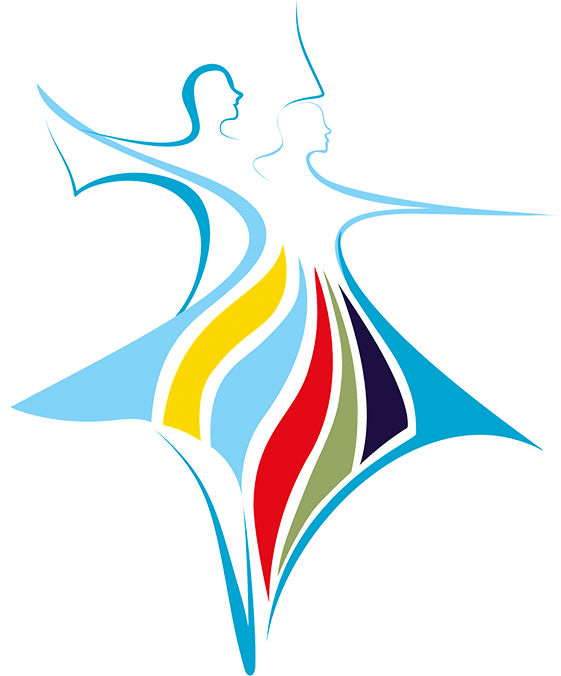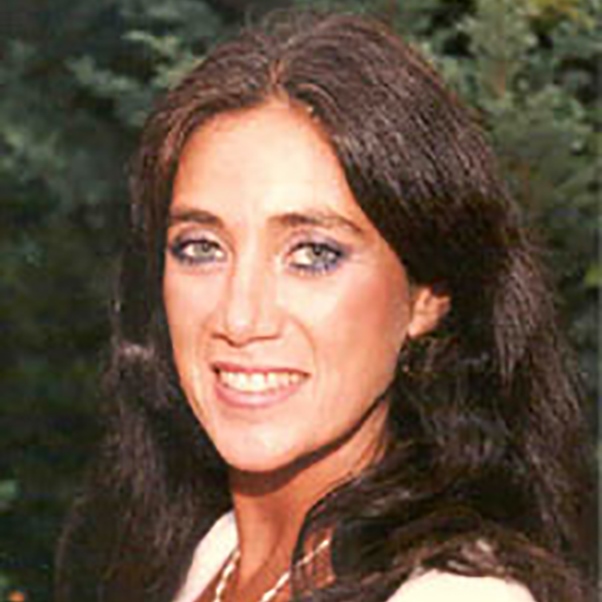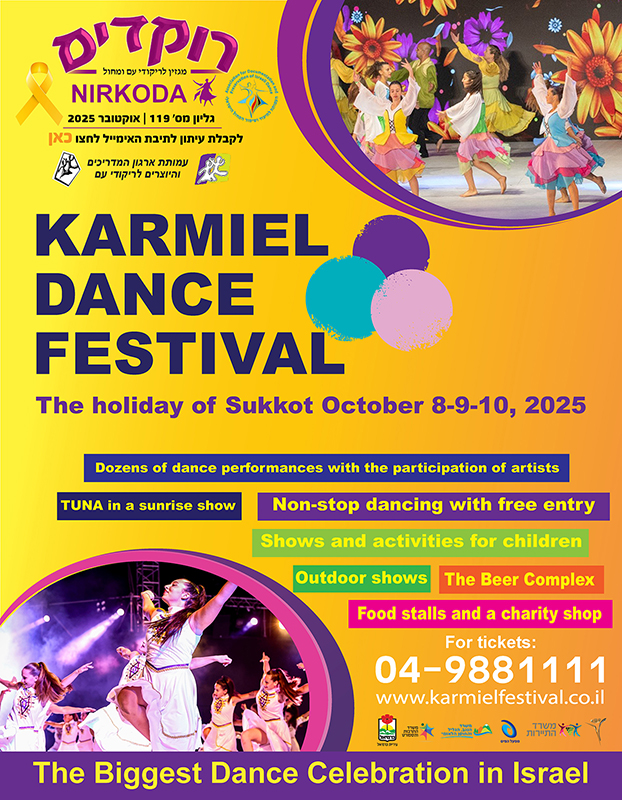- Home
- Rokdim Nirkoda 119
- At Va’Ani – You and I
The Life and Legacy of Danny Uziel z”l
August 1, 1933 – February 19, 2025
During my 1960s New York City High School experience, several of my classmates participated in Zionist youth groups that held weekly meetings and weekend retreats, featuring Israeli folk dance as one of their activities. Having studied ballet as a child and while pursuing a career in ballet, I attended a youth movement weekend and was captivated by an Israeli folk dance called “At Va’Ani.” Upon my return from the weekend, I couldn’t stop thinking about and dancing the dance. Little did I know how prescient this was!
In Israel in 1949, Gurit Kadman, the “Mother of Israeli Folk Dance”, entered a gymnastics club at HaPoel Tel Aviv seeking dancers to join a Chug LeRikuday Am (Folk Dance Club) at HaPoel. [Hapoel Tel Aviv, founded in the 1920s, was part of the “Hapoel” sports department of the Histadrut labor union.] Gurit approached a redheaded young teenager who was a gymnast at the club and called out to him: “Hey Gingy! We need you!” And so began the incredible life’s journey of Danny Uziel.
Birth of a Legend
Danny was born on August 1st, 1933, which corresponded to Tisha B’Av (more about that auspicious beginning later…*) in Tel Aviv. His parents, Regina and Shabtai, had emigrated from Salonika, Greece in 1927.
From gymnast to dancer through Hapoel
When Gurit recruited Danny to join her folk dance club at Hapoel, he did not even know the Hora, since he had never danced before. In the beginning he struggled, but he slowly began to enjoy it and by the end of the year, he had fallen in love – with folk dance!
It was at Hapoel that Danny met the first generation of Israeli dance personalities who performed the traditional dances, “Sherele” and “Debka Rafiach”, at the Dalia Festivals, dances that became the trademark of both Hapoel Tel Aviv and the Dalia Festivals. Danny was selected from the newcomers to fill in on both “Sherele” and “Debka Rafiach”. [Note: The first Dalia Festival, held at Kibbutz Dalia in 1944, was the catalyst for the development of Israeli folk dance. The last Dalia Festival was held in 1968.]
When Yoav and Mira Ashriel, icons of Israeli folk dance in Israel, took the helm of the Israeli Dance Club at Hapoel Tel Aviv in 1951, a performing group was organized, and Danny and Mira become the soloists. In 1955, Danny was asked to join HaLehaka HaMerkazit (The Central Performing Troupe) of the Histradrut. Directed by the legendary Yonatan Karmon, the troupe boasted the top dancers in Israel. In 1956, Danny took over the leadership at the Club; his six-hour work responsibilities included one hour instructing children followed by one hour each for beginner, intermediate and advanced level adults. The final two hours were devoted to the performing group; Yonatan set the choreography and the rehearsals were conducted by Danny. While Danny was teaching the sessions at Hapoel Tel Aviv, he began to introduce some of Karmon’s dances from the performance medleys, such as “Haro’a Haktana”, “Al Tira” and “Yamin U’Smol (Orcha Bamidbar)”. Later, when Danny came to the United States, he introduced these dances as well as nine others from Karmon’s repertoire.
In 1960, the Hapoel Tel Aviv performing group, under Danny’s direction, left for Cyprus, earning the distinction of being the first organized amateur group to perform abroad. In Halehaka Hamerkazit, Danny met Gavri Levi, who, in 1961, asked Danny to be part of a group of three couples that he was organizing for a short tour in Miami. The group was called “The Sabras”, with accordionist Ami Gilad, and drummer Nechemia Sharabi (composer of Debka Uriah). The short trip morphed into a three-year tour of the United States and Puerto Rico. During this period, Danny met his wife, Joanna, and decided to extend his stay in the United States. In 1962, Danny met Fred Berk, the “Father of Israeli Folk Dance in America”, who established the Jewish Dance Division of the 92nd Street Y. It was then that Danny began to give workshops at the Y. At his first workshop, Danny taught Moshiko’s “Debka Uriah”.
In the early years of his time at the Y, Fred worked with an accordionist who was not familiar with the “newer” dances. Conversations between Danny and Fred yielded the idea to produce folk dance records. Ami Gilad served as music director and accordionist with Nechemia Sharabi playing both drums and recorder. These Tikva label recordings featured vocalists Geula Zohar, Ofra Fuchs and Reuven Sheffer, as well as additional musicians including Eliyahu Gamliel on flute and percussionist Ruth Ben-Zvi.
The first record, “Dance Along With Sabras”, was recorded in Buttenweiser Hall at the 92nd Street Y. It included “Haro’a Haktana”, “Al Tira”, “Debka Habir (Debka Uriah)”, as well as “Hanokdim”, which Danny had choreographed in Israel in 1957 and which had already become popular in the United States prior to his arrival. The record was so successful that it was followed by six more.
When Fred asked Danny to create an accessible dance for newcomers, Ami wrote the melody, Nechemia wrote the lyrics, Geula Zohar sang and Danny composed the steps for “At Va’Ani”. The dance has become a classic around the world.
In 1964, when the tour ended, Danny and Joanna married. Danny decided to take a break and raise a family. During this time Danny also established a successful jewelry business featuring his distinctive cameo jewelry designs. But he never completely stopped dancing. A group was organized with Danny’s partner from Halehaka Hamerkazit, Rachel Kugel, and accordionist, Dan Ronen. (Yes, Dr. Dan Ronen who became an academic authority on Israeli folk dance and whose daughter, Dr. Ronit Ronen-Tamir, has continued to cultivate and enrich the world of folk dance.). This trio, “The Three From Judea”, toured throughout the United States and Canada. In 1970, Danny returned to teaching but focused primarily on introducing Israeli dance to the International folk dance community through workshops and regional weekends.
In 1980, Danny returned to the 92nd Street Y and joined me, as I had succeeded Fred Berk upon his retirement. Together, we continued to run the Open Session and special events at the Y until 2020, when, during COVID, Danny moved to California. “Wednesdays at the Y” became a signature weekly Israeli folk dance session. Early on, Danny noticed that the night before Thanksgiving, there were many out of town additional attendees who were home for the holiday. The first of those nights, Danny had us run the session an extra hour for our extra-large crowd to enjoy. This was the catalyst for our annual Thanksgiving Eve Marathons, which drew hundreds of participants from throughout the northeast as well as Canada and became the template for Thanksgiving Eve Marathons throughout the United States.
In 1981, Danny, together with Moshe Eskayo and Moshiko Halevy, organized an Israeli Dance Camp, Hora Shalom, with guests from Israel and with Shlomo Bachar and Israel Yakovee from California. The Camp ran annually until 1990. During and following these years, Danny conducted workshops in North and South America as well as in Holland and Australia.
In celebration of Israel’s 40th anniversary in 1988, the idea arose to hold a major Dance Festival in Israel. Yonatan Karmon was appointed director and approached Danny about bringing groups to represent North America for this first Karmiel Festival. Together with Danny and me, four performing groups and 25 dance leaders from the United States and Canada were invited to participate in the Festival, which became the blueprint for Israel’s internationally recognized annual dance events.
In 1990, Danny and I founded the Israeli Dance Institute, a non-profit educational resource and information center based in New York City. Through IDI, we produced Horati 2001, Horati 2017 as well as numerous projects, events and publications, including the merging in 2004 of IDI’s publication, “Nirkoda”, with the Israeli publication, “Rokdim”, edited by Yaron Meishar, to create the international, bilingual publication “Rokdim-Nirkoda”.
“Horati”, held in 2001 at Hofstra University in Long Island, New York, was an extended weekend event with workshops and performances which marked 50 years of Israeli folk dance in North America and the Jubilee (50th anniversary) of the annual Israel Folk Dance Festival. Participants, dance leaders and performing groups from across the world participated in this landmark event. The Festival 50 performance included a surprise presentation of Moshiko’s staged “Debka Uriah” with Danny leading the dancers, Ami Gilad accompanying on accordion and Moshiko playing the darbouka (doumbek drum).
Danny was perhaps most proud of “Horati 2017 – The World’s Fair of Israeli Folk Dance” which was the realization of his vision that exceeded all expectations. This four-day event featured 15 beloved choreographers from Israel and the United States presenting workshops, performances and harkadot, with many hundreds of Israeli folk dance enthusiasts and performers from all generations throughout the world. Horati 2017 enabled the worldwide community to refresh its love of the soul of Israeli folk dance and set the path to develop a seamless repertoire of dances that will have an enduring appeal to all dancers, groups and sessions. [See: Rokdim-Nirkoda issue 97.]
Among the many individuals that Danny encouraged and projects that Danny helped to initiate were Haim Kaufman and Haim’s organization of the Rikuday Dor Rishon weekly session in 1987 to preserve and perpetuate the classic Israeli folk dances. As Haim recalls, “Danny not only encouraged me, but also supported us enthusiastically over the years with workshops, annual Shorashim weekends and choreographing our performing group. His first workshop for us, in the late 1980s, was most memorable, since he dedicated it to teaching the dances of Yonatan Karmon – of which he was the world’s expert. My most intimate experiences with Danny were when he choreographed our special dance group, starting in 1991, for a performance of the Chassidic style ‘Sherele – Sher’ at the Joe Papp Remembrance I organized at Columbia University’s Earl Hall. [Joseph Papp was a theatrical producer and director. His daughter, Miranda, is an avid Israeli folk dancer.] Danny was in true form that night, leading over 300 people in a Rondo to a medley of Chassidic music. ‘Sherele – Sher’ was very nostalgic for Danny, since he had performed it on stage as a young dancer in Israel”.
When Danny retired from his jewelry business, his local Long Island community seized the opportunity to request that Danny run additional day and evening local sessions. With Danny at the helm, what began as a social gathering for Israelis in the community evolved into a dynamic weekly Israeli folk dance session infused with Danny’s energy and flair for creating an Israeli party atmosphere each night.
In 2005, as part of a special tribute to Danny at the Hilulim Dance Camp in New York, Gadi Bitton surprised him by inviting Yonatan Karmon to come from Israel to celebrate with him. It was an almost overwhelming emotional experience for Danny, bringing him back to his roots and the mentor that molded him in Israel so many years ago to become the dancer with a passion to spread the joy and energetic spirit that defined them both.
Prior to his move to California, Danny was presented with a Lifetime Achievement Award at Camp Bitnua in Israel in 2018.
During COVID, in advance of his move to LA, Karen Kaplan and I organized a special Zoom event in September 2020 – a virtual party honoring Danny and his Israeli dance career of 70 years filled with tributes from friends and dance personalities in Israel and around the world together with videos, games and interactive online fun. The New York Community was thrilled to have Danny return to New York to celebrate his 90th birthday in the summer of 2023 at the 92nd Street Y and with his Long Island session. As on all of Danny’s birthdays, both sessions included his signature dancing of the Greek dance, “Hasapiko”, with all of his unique flourishes that never cease to amaze us!
Ad HaSof – Taking it to the Max
Danny was my wonderful dance and project partner for close to 50 years – a constant source of inspiration with his magnificent dancing, teaching and project direction; his boundless energy, uncompromising pursuit of perfection and visionary leadership that brought so much joy to generations of Israeli folk dancers throughout the world.
COVID and Danny’s move to California did not stop him from continuing to reimagine his Israeli dance journey. As with so many of us, Zoom became the vehicle that kept us together. Danny and I started our weekly “IDI Israeli Dance Circle” on Zoom. Danny would organize the playlist and I would demonstrate and teach from my home. Danny loved engaging with everyone who joined us on Zoom from all over the world. He kept an eye on what dances each participant particularly enjoyed, followed the chats and often followed up with phone calls as this new community was created. He also peppered the session with helpful comments and observations which everyone loved! Danny’s famous adage, “keep dancing”, expressed his fervent belief that dancing is mental, physical and creates community – “chevra”. Since we were all in our homes, I initiated ending our Zoom sessions with a glass of wine – a toast to share with everyone together with our hopes for brighter days ahead. As the circle of life continues, this glass of wine brings us back to Danny’s family’s beginnings in Greece where they owned a winery! Our Zoom session continues with Danny always in our hearts.
Ad Hasof – taking it all the way through – to the MAX – is a marvelous metaphor for how to live – how Danny lived his life through the dance of life! Dance is more than a series of steps. As Danny always said, “Dance the music – not just the steps – Ad Hasof!”
A teacher is more than someone who just imparts information or a series of steps. Danny was the consummate teacher, with the ability to lead the crowd and to adjust to each situation, picking the perfect repertoire for each group. We marveled at his impeccable sense of timing and knowing how to perfectly balance a program. Yet nothing was ever good enough in Danny’s eyes: it always had to be and could be better and better. Danny helped us all to appreciate better and better and better – keeping everything fresh and always giving us more – Ad Hasof!
Danny made every moment count. His passion for perfection and abundance of positive energy made everything he touched come alive. His undeniable “gingy” spirit propelled him and all who came with him to appreciate and cherish every single moment.
Whether in person or on Zoom his indomitable dance spirit that was inexorably bound within his soul continued to bring us great joy – Ad Hasof!
Danny was indeed a treasure, cherished by our global community of dancers and by all whose lives he touched.
Danny was grateful to have witnessed the beginning of Israeli folk dancing and to have been able to keep up with the new generation of choreographers and the ever-increasing repertoire of dances. In addition to his dances, classic dances “At Va’Ani” and “Hanokdim”, Danny choreographed dances that became especially popular in international dance circles such as “Chassidic Melodies”, “Bat Arad”, “Bo’i Tama” and “Dos Amantes” that we revived on Zoom. Danny also choreographed for my performing ensemble, Parparim, most notably, “Betof U’Machol – With Drum and Dance” and was instrumental in expanding the scope of our annual Israel Folk Dance Festivals.
Danny’s passion for dance was matched by his passion and devotion to his family and to his personal “next generation”, to his wife, Joanna, their daughter Nina and her husband Rich, their son Oren and his wife Helen, and their granddaughters, Isabella (Izzy) and Vivian (Nina and Rich) and Hildy and Asta (Oren and Helen).
This past summer on July 27th, just shy of what would have been his 92nd birthday, we held a special event at the 92nd Street Y celebrating Danny’s life and legacy together with his family and hundreds of friends from all generations, both in-person and on Zoom. It was an afternoon filled with memories, dancing and love; that, in true Danny Uziel fashion, was his wish for us, to CELEBRATE his life when he was no longer here to join us on the dance floor. Links to videos, photos and memorabilia, including heartwarming reflections from Danny’s family, will be posted by IDI soon.
May the immeasurable joy Danny gifted to the Israeli and international folk dance community through his dances, his inspired teaching, guidance, elegant dancing, boundless energy and visionary leadership forever dance in our hearts!
*Closing note
Let’s put the pieces together: Danny, a “gingy” born on Tisha B’Av, to a Sephardic family…all that’s missing is his “Sus Halavan” (white donkey) to perhaps be a precursor of what Judaism intimates will bring ultimate resilience and joy…!)
Also see Danny’s articles: “From the Suites on the Stage to the Dancing Halls” in Rokdim-Nirkoda issue 103 (dedicated to Yonatan Karmon z”l), and “A Team That Complemented Each Other” in Rokdim-Nirkoda issue 105 (dedicated to Yoav Ashriel z”l).









Comments
התראות